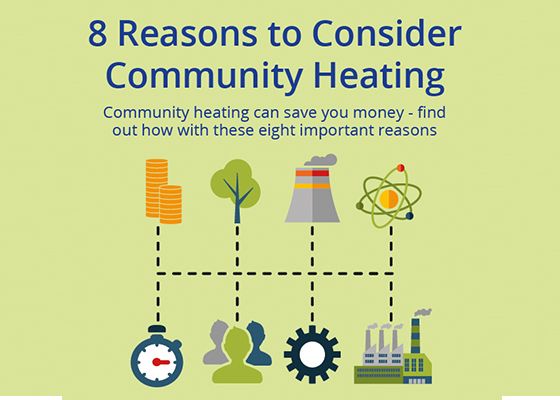
Community heating can save you money - find out how with these eight important reasons
What is a district heating system?
Also known as community heating, a district heating system consists of one or more centralised sources of hot water which is then distributed to consumers via a buried network of highly-insulated pipes.
According to government figures, nearly a half of the heat demand in England is sited in clusters that make community heat networks possible.

Gr8 expectations
The UK District Energy Association identifies eight chief benefits from community heating.
1. Improved energy efficiency
2. Enhanced environmental protection
3. Fuel flexibility
4. Ease of operation and maintenance
5. Reliability
6. Comfort and convenience for consumers
7. Reduced costs
8. Increased functional space on-site
Energy efficiency – one for all
According to the government’s Community Energy Programme, energy savings from a single community heating system are typically:
- 25% compared to individual gas boilers.
- Up to 50% compared to electric heating.
Where combined heat and power (CHP) is deployed, the heat normally lost from a generator in a power station can be used to heat water for district heating.
In conventional electricity generators, less than half of the energy from burning fuel ends up as electricity - the rest goes up the flue. CHP can boost the heat-to-power to 70%.
Environmental protection – a pollution solution
More efficiency means less carbon.
Renewable fuels such as biomass increase the carbon reductions.
Typical carbon dioxide emissions [g/kWh] of different heating systems:
| District heating | Individual heating | ||
| CHP gas | 10 | Gas boiler | 260 |
| CHP coal | 270 | Coal fired boiler | 530 |
| Biomass | 30 | Oil fired boiler | 350 |
| Waste incineration | 20 | Electric heating | 850 |
| Oil | 360 | Heat pump | 300 |
Flexibility - Watts you want
Community heating systems can be set up to switch at short notice between fuels such as natural gas and biogas, depending on which fuel is cheapest or most available.
Community heating systems can use fuels that are not plausible options in individual domestic heating.
Examples:
- CHP from thermal power plant or industrial sites.
- Energy from waste or waste heat from industrial processes.
- Geothermal and solar arrays.
- Fuel cells.
- Heat pumps.
Operations and maintenance - no worries.
Community heating passes the operational risk to the energy supplier who is contracted to deliver heat or cooling to the consumers’ buildings, proving a good mechanism for protecting vulnerable residents.
Reliability – sure fire
Well maintained community heating systems follow industry standard preventative maintenance regimes and utilise BMS systems which are monitored around the clock and can include backup systems.
Most show reliability levels above 99% - outstripping gas and electricity distribution networks.
Convenience – familiar territory
In most instances, community heating systems within property internals provide heat in the same way as conventional gas-fired central heating systems - through pipework, radiators and by using the same types of controls.
No gas boiler means no need for an annual gas safety inspection in each property.
Reduced costs - the final bill
Upfront costs are high but once the costs over the whole life of the equipment are accounted for, a community heating system is cheaper than in-house heating.
For example:
A community heating system will keep working for 25 years, with pipework lasting for 50.
Compare that with:
individual gas boilers lasting 15 years and electric storage heating lasting 10 years.
Community heating consumers have no boilers or chillers in their property so their financial risk is decreased, as are the costs of parts, labour and insurance.
New build costs are less than retrofit costs. Payback can be less than 10 years.


